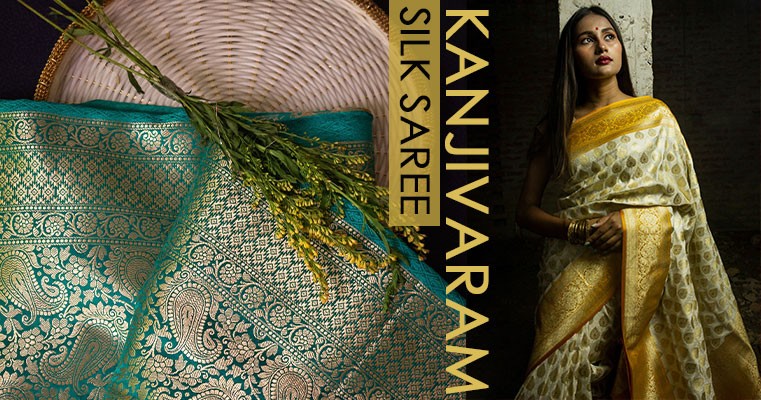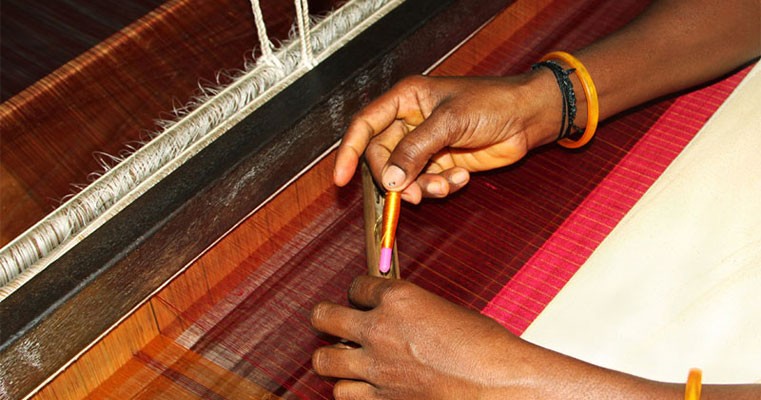Kanchipuram Sarees-History, Characteristics and Making

Hand-woven fabrics are a source of tremendous pride for Indians. They signify Indian identity, culture, and heritage and have a series of historical stories woven into their threads. The majestic temple city of Kanchipuram in southern India is home to one of India's oldest and most prominent hand-woven industries.
Under the Chola dynasty's patronage, the region flourished as a spiritual and learning centre, and the Kanchipuram weaves reflect their culture, personality, and charm, which may still be observed now.
History and origins of Kanjeevaram Sarees
The origins of the Kanjeevaram silk sari can be traced back to Hindu mythology. According to legend, the Kanchi Silk Weaver is a descendant of Sage Marcanda, known as the Gods' Master Weaver.
The world famous Kanchipuram Saree weave dates back 400 years and is located in the little town of Kanchipuram (Tamil Nadu). During Krishna Devalaya, art was born (of the Vijayanagar Empire). Devangas and Saligers, two big weaving groups from Andhra Pradesh, have relocated to Kanchipuram. Silk saris with images of inscriptions and figures seen in temples around the area were created using superior weaving skills.
In South India, the Kanchipuram Silk Saree, also called as Kanjivaram Saree, is frequently compared to the Benarsi Saree. Because of its thick fabric and bright gold colours, this sari is suitable for formal gatherings and celebrations. Kanjeevaram or Kanchipuram silk saris are the perfect choices if you're seeking an elegant ethnic alternative.
Saree has become a must-have for women in traditional ceremonies, weddings, and other events in South India.
The Weaving Process

Pure mulberry silk is used to weave the Kanchipuram silk sari. Even though silk is native to southern India, pure gold and silver zari is native to Gujarat. Then, the silk thread used to weave saris is steeped in rice water and dried in the sun before use to increase both thickness and rigidity. Once done, the weaver uses the silk thread with a fine silver wire and finishes it with the gold thread to complete the technique.
To give it a robust feel, the warp frame used to weave this fabric includes 240 holes in the warp and around 60 holes in the weft with 250-3000 threads. Saree's pallu, border, and body are usually knitted individually and then stitched together extremely precisely and cleanly, giving the Kanchipuram saree its traditional look.
Characteristics of Kanjeevaram Silk Sarees
Because of the huge colour and design variances between the body and the pallulu, the weaver weaves them separately before combining them. The zigzag pattern (known as Pitni) can be seen where the body meets Pallu.
It's also typical to weave the three sari borders individually before putting them together. When the sari tears, the three connections (known as korvai) are established precisely so that the borders do not weaken.
The fabric is highly tough and durable since the Zari is formed by twisting three silk threads with silver wire. This can, however, add weight, and a Kanjeevaram sari can weigh up to 2 kilogrammes.
The Colours of Kanchipuram
Saree is recognised for her vibrant colours and eye-catching patterns, mostly influenced by the books and figurines seen in many of the village's temples. Saree's pallu and body are different colours and designs, so expect a wide range of tints.
The Motifs found on Kanchipuram Sarees
Kanchipuram's Silk Saree has faithfully included temple motifs and mythical legends into its creations from its debut. The perimeter of the
The body of Saree features pyramid-shaped temple designs, checks, stripes, floral buttas etc. however, the motifs have changed over the years and now consists of fruits, animals, birds, the sun, the moon, and even mythological stories have replaced conventional and highly appreciated striped or gold dot designs over the years.
The Varieties of Kanchipuram Silk Saree
The Kanchipuram silk sari was initially woven in a 9-yard weave, but more practical 6-yard weaves have been introduced throughout time. The original gold and silver shavings have been replaced by metal or copper shavings, maintaining the texture's lustre while lowering expenses. However, if you require the original, you must ensure that the Zari work is genuine.
The Current State of Kanchipuram Sarees
Since 2006, the government has designated the Kanchipuram sari as a geographical designation. This is confirmation of authenticity, and it has helped the Kanzi Balaam Silk Saree sell more. Approximately 5,000 families are currently employed in the industry, supported by 15 silk and cotton factories and 60 dyeing companies.
In 2008, a Tamil film titled Kanchivaram was released about weavers, which helped bring their issues to the general public's attention. The government also implemented a programme to stimulate the electronic marketing of local weavers.
Thirteen e-commerce companies have teamed up with the Development Committee (Handlooms) to sell hand-woven goods created by the weavers themselves. This implies that if you buy a Kanchipuram sari online, you can get the cloth directly from the weaver and get the finest of the finest Kanchipuram.
Kanchipuram saree- real or not?
Kanchipuram's sari is distinguishable because of mulberry silk and pure zari. The weaver's family utilises professional skills to twist, spin, dye, and weave these threads into a gorgeous Kanchipuram sari, with over 150 years of experience passed down from generation to generation.
Its elegance is enhanced by the use of rich golden and brocade fabrics, as well as contrasting trimming. It's no surprise that a genuine Kanchipuram Sari is equally as opulent and pricey.
Here are the top ten points to remember while identifying this classic weave.
1. To recognise a genuine Kanchi plum sari, you must first comprehend the purity of the thread used to weave it. Compared to mixed alternatives, pure silk is of greater quality and costs less.
2. To do so, look for the "Silk Mark," an Indian silk board accreditation granted solely to saris manufactured of genuine Kanchipuram. Touch and Feel is a fun approach to finding out who the Silk Queen is. Between your pallums, rub the cloth. Unlike the equivalent saris, pure silk saris are warm to the touch. The edges should also be soft and smooth, with no grain or rough texture.
3. The Royal Silk Sari of Kanchipuram is supposed to be pearly and elegant. Pure silk's shimmer and brilliance reflect light differently depending on the angle, giving it a two-tone appearance.
4. Kanchipuram saris are distinguished because they are created, woven, and handcrafted by skilled artisans using traditional techniques. There are some imperfections in the fabric compared to the power loom cloth because of the manual labour. Keep a lookout for this sign of uniqueness, then flip Saree inside out to unveil the hidden masterpiece.
5. Korvai, a knot and weaving technique that smoothly combines independently weaved bodies and pallulu, brings weaving to life. Many unique forms and patterns result from this confluence, which was highly influenced by the arches of South Indian temples. Look for fuzzy zigzag patterns to recognise the true Kanchipuram weave.
6. The three shuttle weaves are another key feature of the Kanchipuram sari. This is an old technique for securing the Zari's borders at both ends not to loosen when the sari tears. As a result, correctness, perfection, and emotion are unquestionably the hallmarks of this curtain.
7. When making Kanchipuram saris by hand, zari is very significant. Today's market sells cheap, low-quality imitations and alternatives in the form of tested sari, traditionally fashioned pure gold and silver.
8. Scratch gently to detect pure Zari. It should have a reddish appearance rather than the white appearance others have. Looking at the borders of the sari when purchasing Kanchipuram dough is a noteworthy feature to keep in mind. The loom secures the sari to the loom for hand-woven drapes. Finding a pinhole, therefore, indicates that actual technology is being employed.
9. The colour palate of vintage Kanchipuram weaves notable for its contrast between the body, border, and pallu. It has a fantastic appeal thanks to its bright pleats and wrinkles. There's no need to be concerned about the colour fading over time.
10. The Ring test is an intriguing method of determining whether or not a Kanchipuram is genuine. It is believed that if Kanchipuram Saree passes through a ring, it is real.
Guide on Taking Care of Your Kanchipuram Sarees
Dry cleaning is the most popular method of preserving the saree. However, if you do need to wash the saree at home, avoid using soap during the first three washes. A simple washing in cold water would suffice. Keeping the saree in a plastic or saree bag one at a time is quite beneficial.
Latest Posts
Categories
Tags


 +1-403-351-7777
+1-403-351-7777














